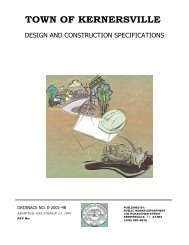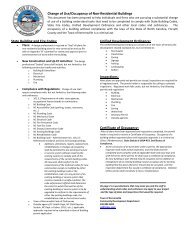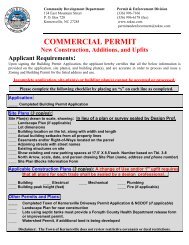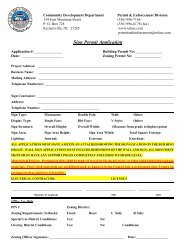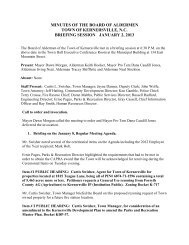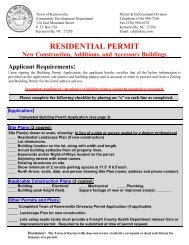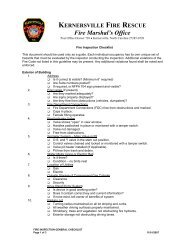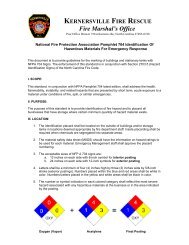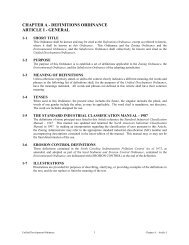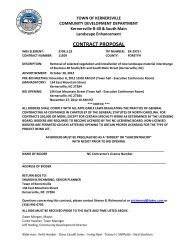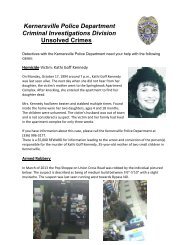Piedmont Greenway Master Plan - Town of Kernersville
Piedmont Greenway Master Plan - Town of Kernersville
Piedmont Greenway Master Plan - Town of Kernersville
- No tags were found...
You also want an ePaper? Increase the reach of your titles
YUMPU automatically turns print PDFs into web optimized ePapers that Google loves.
OVERVIEW AND INTRODUCTION<br />
Since the first city was founded in the heart <strong>of</strong> the <strong>Piedmont</strong>, the region has been recognized as one <strong>of</strong><br />
the best places to live in the South. The region’s popularity stems from the natural amenities <strong>of</strong> the <strong>Piedmont</strong>,<br />
combining the friendly atmosphere <strong>of</strong> small towns such as <strong>Kernersville</strong> and the cultural activities <strong>of</strong> the larger<br />
cities <strong>of</strong> Winston-Salem and Greensboro. Tourists and other visitors come to see a wide range <strong>of</strong> attractions,<br />
such as Old Salem Village and Wake Forest University, and many choose to make Forsyth and Guilford counties<br />
their permanent homes, creating a growing urban area.<br />
The development <strong>of</strong> a comprehensive greenway system will enhance the region’s natural amenities.<br />
<strong>Greenway</strong>s are linear corridors <strong>of</strong> natural land that serve a variety <strong>of</strong> purposes, especially when trails are<br />
developed within these corridors. As an alternative transportation route, tourist attraction and natural<br />
resource corridor, a central continuous greenway in Forsyth and Guilford counties affords important<br />
connections between workplaces and homes, shopping areas and neighborhoods, parks and schools,<br />
historic sites and hotels, rivers and ridge tops and lakes and valleys. A central greenway developed as a<br />
continuous link between the cities <strong>of</strong> Winston-Salem and Greensboro will bring further recognition to<br />
the region for its quality <strong>of</strong> life. <strong>Greenway</strong>s have also been proven to attract new business.<br />
Today, many <strong>of</strong> the features that drew new families to the region are threatened by growth and development.<br />
With few exceptions, the region is not a friendly place for bicyclists or pedestrians, especially in<br />
recently developed areas. Once it was easier and safer to travel on foot or by bicycle between neighborhoods<br />
and such destinations as local schools, parks, shops, restaurants and businesses. Today, these connections<br />
have been severed by the development <strong>of</strong> highways, unsafe intersections, sprawling land uses (increasing distances<br />
between destinations) and other automobile-oriented hazards that serve as physical and psychological<br />
barriers to bicycle and pedestrian travelers. To reach the city from either Greensboro to the northeast or Winston-Salem<br />
to the southwest tourists must negotiate strip commercial development and four-lane roadways, an<br />
unattractive prospect even for motorists. Tourists are <strong>of</strong>ten forced to remain in their cars instead <strong>of</strong> bicycling<br />
or walking around the area. Encouraging tourists to use bicycles or to walk will generate more tourist revenue<br />
for local businesses.<br />
Not only have connections between popular origins and destinations in the region been severed, but the<br />
community’s physical connections to its rivers and ridges have been limited. Many residents are unaware<br />
<strong>of</strong> the existence <strong>of</strong> the region’s lakes and creeks, even though they may drive across them on a regular basis.<br />
Encroachment by residences and businesses on these waterways has led to water quality degradation and<br />
increased the potential for flooding. The parks serving the region <strong>of</strong>fer residents and visitors excellent outdoor<br />
recreation opportunities, including trails along the major sites <strong>of</strong> Salem Lake, Lake Brandt and Lake Higgins.<br />
However, continuous public open space within the central core <strong>of</strong> the counties is minimal.<br />
Additionally, as is common in many other urban areas throughout the country, Forsyth and<br />
Guilford counties are beginning to experience the problems that accompany rapid growth, including<br />
increased traffic congestion, diminishing air and water quality, a loss <strong>of</strong> wildlife habitat and<br />
natural lands, and fewer close-to-home recreational opportunities.<br />
Responding to these growth problems, the <strong>Piedmont</strong> Land Conservancy (PLC) asked<br />
<strong>Greenway</strong>s Incorporated to assist the communities <strong>of</strong> Forsyth and Guilford counties in developing<br />
a <strong>Piedmont</strong> <strong>Greenway</strong> <strong>Master</strong> <strong>Plan</strong>. Prior to the initiation <strong>of</strong> the <strong>Master</strong> <strong>Plan</strong>, PLC is already at<br />
work in both counties and the region, negotiating with landowners to acquire land for greenways<br />
and other purposes.<br />
<strong>Greenway</strong>s Incorporated is a nationally recognized multi-disciplinary environmental planning<br />
and design firm that specializes in providing consulting services to government agencies, for-pr<strong>of</strong>it<br />
corporations and nonpr<strong>of</strong>it organizations. Their chosen pr<strong>of</strong>essional focus is greenway planning,<br />
design, development and management and they have provided services to more than 120 communities<br />
in 28 states. Chuck Flink, the president <strong>of</strong> the firm, participated in the development <strong>of</strong> the<br />
Bethabara <strong>Greenway</strong> in Forsyth County and the Bicentennial <strong>Greenway</strong> in Guilford County prior to<br />
the firm’s producing the <strong>Piedmont</strong> <strong>Greenway</strong> <strong>Master</strong> <strong>Plan</strong>.<br />
In association with local residents, the cities <strong>of</strong> Winston Salem, Greensboro and <strong>Kernersville</strong><br />
planning <strong>of</strong>fices, parks and recreation departments and other municipal government staff,<br />
<strong>Greenway</strong>s Incorporated has prepared this <strong>Master</strong> <strong>Plan</strong> report. The report and associated graphic<br />
elements represent initial investigations and evaluation <strong>of</strong> the <strong>Piedmont</strong> <strong>Greenway</strong> as a future multipurpose<br />
transportation corridor bridging the counties <strong>of</strong> Forsyth and Guilford and connecting the<br />
cities <strong>of</strong> Winston Salem, <strong>Kernersville</strong> and Greensboro.<br />
This report is divided into several sections describing the existing conditions <strong>of</strong> the project<br />
corridor, incorporating the comments <strong>of</strong> local residents who participated in the master planning<br />
process, making design development recommendations and estimating probable costs. The report<br />
also includes a recommended phasing strategy for the project and an action plan for involving local<br />
residents in the development and management <strong>of</strong> the <strong>Piedmont</strong> <strong>Greenway</strong>.<br />
The <strong>Piedmont</strong> <strong>Greenway</strong> <strong>Master</strong> <strong>Plan</strong> <strong>of</strong>fers new opportunities for broadening community<br />
interaction and enhancing the environment in one <strong>of</strong> the state’s most attractive growth areas.<br />
PIEDMONT GREENWAY<br />
Final <strong>Master</strong> <strong>Plan</strong> Report 3



